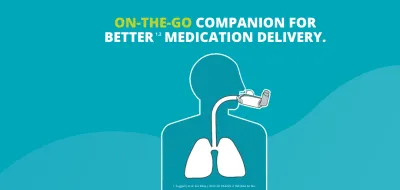OBJECTIVE
Asthma control and global warming are important issues that have significant impacts on human health and the environment.
It is critical however to ensure that maintaining or improving the patient’s asthma control goes hand in hand with environmental actions.
This lab study investigated how to optimize the modelled lung delivery while at the same time minimizing the carbon emissions from the MDI.
METHOD
Two different salbutamol MDIs (Ventolin†, Salamol†) were investigated and tested alone and combined with an AeroChamber2go* Spacer, designed specifically for on the go use with reliever medications.
Fine particle mass (FPM, < 4.7μm), the mass of drug in the size range potentially available for lung delivery was determined using a cascade impactor, performed with no delay following actuation, and HPLC assay.
Drug delivery was equated to a potential relative carbon footprint based upon published claims.1
RESULTS
More efficient delivery of inhaler medication leads to less use of medication and therefore less carbon footprint. See the results below:



CONCLUSION
The use of this spacer with a lower carbon emitting salbutamol MDI has the potential to improve lung delivery and reduce carbon emissions.
The selection of the Salaml† MDI delivered using the AeroChamber2go* Spacer could potentially reduce the number of actuations required for patient relief of symptoms, which could help contribute to an up to 4.5x reduction in the carbon emissions compared to using a Ventolin† MDI product alone.
1 https://www.prescqipp.info/ 2 United Nations. Montreal protocol on substances that deplete the ozone layer. 2018 report of the medical and chemical technical options Committee (MCTOC), 2018. Available: https://ozone.unep.org/sites/default/files/2019-04/MCTOC-Assessment-Rep…. pdf [Accessed 21 Nov 2019].
3 Panigone S, Sandri F, Ferri R, et al. Environmental impact of inhalers for respiratory diseases: decreasing the carbon footprint while preserving patient-tailored treatment. BMJ Open Resp Res 2020;7:e000571. doi:10.1136/ bmjresp-2020-000571 4 Tennison et al. Health care’s response to climate change: a carbon footprint assessment of the NHS in England. Lancet Planet Health 2021; 5: e84–92.
MD-304A-0723 * trade marks and registered trade marks of Trudell Medical International (TMI). † trade marks of their respective companies. ©TMI 2023.
